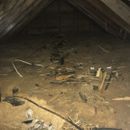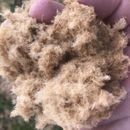What kind of insulation is this?
I am remodeling a home that was built in 1902 and remodeled in 1977. This insulation was blown in the attic in 1977. What kind is it, and should we be concerned about asbestos?
Thanks!
GBA Detail Library
A collection of one thousand construction details organized by climate and house part











Replies
Looks like mineral wool.
Looks more like wood fiber insulation than mineral wool. Loose-fill fiberous asbestos insulation was usually gray, though some were brown.
https://isofloc.com/our-insulation-products/isofloc-woodfiber/
In the US note that asbestos was banned for most building insulation purposes in 1973, so if it was installed in 1977 it's pretty unlikely to be asbestos. I'm not sure about when they stopped using it in Canada.
You may be able to tell by feel. Otherwise, take it outside, see if it's possible to set it on fire with a propane torch. If it burns, it's not asbestos. If it melts at the blue flame tip it's probably fiberglass, and definitely not asbestos. If it can be heated to where it glows orange but doesn't melt or burn it's either rock wool or asbestos.
Hi Dana.
I've read and learnt a lot from you. And I know this is probably not the right way, but if you may please reply to https://www.greenbuildingadvisor.com/question/dense-packed-cellulose-against-above-grade-concrete
I would be very thankful.
Most asbestos found in residential attics was there accidentally, a contaminant in vermiculite, mostly from a mine in Libby, Montana. This mine remained in operation until 1990, so while asbestos may have been banned in 1973, attics insulated into the early 1990s are still potentially at risk. The insulation in question here doesn't look anything like vermiculite, but for the benefit of someone finding this thread later on I thought it was important to point out.
The burn test can also be misleading. If it burns, all that it tells you is that some of it is not asbestos. It doesn't mean there is none in there.
Hey J,
Doesn't look like asbestos or fiberglass to me, but it's hard to tell. This FHB article has a lot of info on identifying old insulation, you may find it helpful. Please be careful. I wouldn't mess with it too much until you are sure what it is.
https://www.finehomebuilding.com/2009/09/17/new-insulation-for-old-walls
Dana, what would the differences be to touch?
I tried to burn some and it just turns red. If it were wood fibers, and they were treated with fire retardant, would it turn red? Or smoke?
Fire retardants don’t make materials fire proof. You can still burn treated materials, but they’ll usually self extinguish when you remove the source of ignition. Basically if it’s treated wood fibers, they’ll burn while in the flame of the torch, but when you take the torch away, the fibers will stop burning in a short period of time.
Mineral wool and asbestos won’t burn at all. They might glow from the heat, but they won’t smoke or burn, even while the fibers are in the flame from the torch.
The asbestos I’ve usually seen has been grayish white, sometimes light yellow, and I’ve heard there is some purple stuff that is nasty but I’ve never seen it. Most of my experience with it has been with high temperature wire insulation though.
Bill
Thanks, Bill!
Attached is a video of burning some, that was wet. It definitely ignited and smokes. Thoughts on that?
If it ignites (rather than melts) and smokes under intense flame it's probably wood fiber insulation (treated with a fire retardent), definitely not rock wool, definitely not asbestos.
If you have a sample of some fiberglass insulation to test, torch that and see how long it takes to melt.